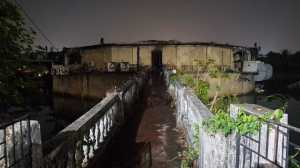Cyclone Alfred in Australia: What makes it rare and potentially more dangerous
Cyclone Alfred is unusual for two reasons — it has formed way too south, and is moving slowly. Both these factors make it more dangerous. We explain why.
 Big Waves at Currumbin Vikings Surf Club before the landfall of Cyclone Alfred, on the Gold Coast, Australia, March 6, 2025. (Photo: Reuters)
Big Waves at Currumbin Vikings Surf Club before the landfall of Cyclone Alfred, on the Gold Coast, Australia, March 6, 2025. (Photo: Reuters)As of Thursday evening (March 6), Cyclone Alfred is making its way towards Australia’s east coast, threatening to dump massive amounts of rain in an area unprepared to deal with such tropical storms.
The cyclone is unusual for two reasons — it has formed way too south, and is moving slowly. Both these factors make it more dangerous. We explain why.
According to Australia’s Bureau of Meteorology, Alfred is moving towards the southeast Queensland coast. It is a category 2 storm (which depends on wind intensity), with sustained winds near the centre of 95 kilometres per hour and wind gusts upto 130 kilometres per hour. It is likely to “affect Double Island Point in Queensland to Grafton in New South Wales, including Brisbane, Gold Coast, Sunshine Coast, Byron Bay and Ballina.”
Wind and rain are already lashing the affected areas.
What makes Cyclone Alfred rare?
Usually, cyclones hit Australia’s northern areas. In fact, the last time a cyclone struck the Gold Coast area was in 1974, with Cyclone Zoe. The south of Australia is more heavily populated, with Brisbane the country’s third most populated city.
This means that close to four million people are in the path of Cyclone Alfred, with the infrastructure here not built to weather storms.
“This is a rare event, to have a tropical cyclone in an area that is not classified as part of the tropics, here in southeast Queensland and northern New South Wales,” Australian Prime Minister Anthony Albanese told reporters in Brisbane, as quoted by Euro News.
Cyclone Alfred’s unusual path is because it encountered a high pressure system over the Tasman Sea, which made it turn westward. “Alfred’s abrupt westward shift is due to a large region of high pressure to its south, which has pushed it directly towards heavily populated areas of southeast Queensland and northern New South Wales. These steering winds are not very strong, which is why Alfred is moving slowly,” an article on the website of Australia’s national science agency CSIRO said.
While it can’t be definitely said that this happened due to climate change, the effects of climate change have been making cyclones more erratic over the years.
Why is Cyclone Alfred slow, and why is that a problem?
Alfred was initially expected to make landfall late on Thursday or early Friday, but is now likely to make landfall only by Saturday morning. The slower a cyclone moves — basically, the longer it hovers over a region — the more rain it dumps. Once a cyclone has made landfall, it has less moisture to feed off and thus its intensity decreases. This doesn’t happen if it is moving slowly.
“Alfred’s slowing means the huge waves triggered by the cyclone will last longer too, likely making coastal erosion and flooding worse,” the CSIRO article says.
Alfred is moving slowly because the winds driving it are not too strong.
What exactly is a tropical cyclone?
According to the World Meteorological Organisation (WMO), “A tropical cyclone is a rapidly rotating storm that begins over tropical or subtropical oceans, with very violent winds and torrential rain; sometimes accompanied by thunderstorms.”
When a low pressure system develops over warm tropical sea waters, it causes warm, moist air to rise. As this air rises, because of the Earth’s rotation, the winds begin to spin.
When wind speed exceeds 63 kph, the term ‘Tropical Cyclone’ can be used for the weather system, according to the WMO.
- 01
- 02
- 03
- 04
- 05






































